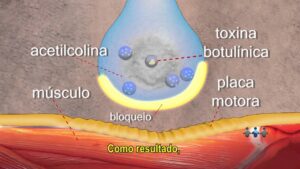Botulinum Toxin Halo of Action
Botulinum Toxin is a substance produced by the bacteria Clostridium botulinum and has a wide range of applications both in the aesthetic and therapeutic areas. In this article, we will discuss the Botulinum Toxin action halo, what it is, how it works and the factors that influence its action.
What is Botulinum Toxin?
History of Botulinum Toxin
Botulinum Toxin was discovered in 1895 by the Belgian physician Émile Van Ermengem, after investigating an outbreak of foodborne botulism. Since then, its use has been widely studied and developed for various purposes.
Types of Botulinum Toxin
There are several types of Botulinum Toxin, the best known and most used in clinical practice being type A and type B.
How does Botulinum Toxin work?
Mechanism of action
Botulinum Toxin works by blocking the release of acetylcholine at neuromuscular junctions, causing temporary paralysis of the muscle. This effect is useful both for aesthetic purposes, such as treating wrinkles and fine lines, and for therapeutic purposes, such as treating spasticity and other medical conditions.

Botulinum Toxin can be applied to different areas of the body, including the face, neck and hands, depending on the purpose of the treatment and the patient's clinical conditions. Among the most common applications are the treatment of forehead wrinkles, crow's feet, platysmal bands on the neck and hyperhidrosis.
And after all, what is the Halo of action of Botulinum Toxin?
What is the action halo?
Botulinum Toxin's halo of action refers to the area around the point of application where the substance takes effect. In other words, it is the extension of the area of influence of the toxin in the treated tissue. The halo of action is important to guarantee the effectiveness and safety of the treatment, avoiding unwanted effects and unsatisfactory results.
Factors that influence the halo of action
The Botulinum Toxin halo of action can be influenced by several factors, such as the application technique, toxin concentration, injection depth, amount applied and individual characteristics of the patient, such as age, skin thickness and muscle tone.
Botulinum Toxin Diffusion Halo
The diffusion halo of Botulinum Toxin is related to the way the substance spreads in the tissue after its application. It is an important aspect to understand how the toxin acts in the body and how to obtain more accurate and effective results in aesthetic and therapeutic treatments.
Understanding the halo of diffusion
Diffusion halo occurs when Botulinum Toxin spreads beyond the injection site, affecting adjacent tissues. This dispersion can be beneficial in some cases, such as smoothing wrinkles and expression lines, where it is necessary for the toxin to act on a larger area than the point of application.
However, the excessive halo of diffusion can lead to unwanted effects and complications, such as paralysis of unintended muscles and spread of the toxin to areas far from the application site.
Factors that affect the halo of diffusion
There are several factors that can affect the diffusion zone of Botulinum Toxin, including:
- Toxin dilution: Dilution of the toxin may influence the diffusion halo, as a greater amount of serum may increase the dispersion of the substance in the tissue. It is essential to follow the manufacturer's recommendations for the correct dilution of the toxin.
- application technique: The technique used to apply Botulinum Toxin also affects the diffusion halo. The injection needs to be done at the correct depth and in the appropriate place, according to the purpose of the treatment and the anatomy of the patient.
- Individual patient characteristics: Some patient characteristics, such as skin thickness, muscle tone and the presence of adipose tissue, may influence the diffusion of the Botulinum Toxin in the organism.
Importance of controlling the diffusion halo
Controlling the Botulinum Toxin diffusion halo is crucial to ensure effective and safe treatment results. Trained professionals must take into account all factors that affect the spread of the toxin and apply it accurately and appropriately. In addition, it is important to perform post-treatment follow-up to monitor the patient's response and make adjustments if necessary.
Botulinum Toxin Online Course – Full Face Academy

💉 Botulinum Toxin: Preparation, Application and Clinical Cases.
💬 Practical tips to improve your skills.
📋 Explore real cases and success studies.
🚀 Be a high-level professional.
📽️ 4K high resolution content so you can see the smallest details
📚 Exclusive material to improve your knowledge.
📈 Increase your revenue with Marketing techniques to retain recurring patients.
Clinical Applications of Botulinum Toxin
aesthetic applications
In the aesthetic area, Botulinum Toxin is mainly used to treat wrinkles and expression lines, such as the aforementioned forehead wrinkles, crow's feet and bands. platysmal. In addition, the toxin can be applied to treat gummy smile and to improve the appearance of the chin and nose.
therapeutic applications
In the therapeutic area, Botulinum Toxin has several applications, such as in the treatment of neuromuscular disorders, such as spasticity, dystonia and blepharospasm. Other applications include the treatment of chronic migraines, hyperhidrosis and strabismus.
Contraindications and precautions
Botulinum Toxin is contraindicated in patients with allergy to the substance, infection at the application site, neuromuscular diseases and during pregnancy and lactation. In addition, it is important to carry out a detailed medical evaluation before treatment, to ensure the safety and effectiveness of the procedure.
Side effects and complications
The side effects of Botulinum Toxin are generally mild and temporary, including pain and swelling at the application site, headache and bruising. More serious complications such as unintentional muscle paralysis and spread of the toxin to other areas as in the case of ptosis after botox, are rare, but may occur in cases of inappropriate techniques or excessive doses.
Service Sheets for Facial Harmonization Professionals

📂 Editable 100% PDF documents, customizable with logo.
💎 Developed by renowned experts in the field.
🚀 They make daily work easier with clear and objective information.
⏱️ Speed up patient care.
🔒Increase safety and confidence in the procedures carried out.
🌟Possibility of offering a personalized experience to customers. 🌟
Be ahead in the world of Facial Harmonization with our Service Sheets!
Get it now and raise the level of your practice!
Care after treatment
After the application of Botulinum Toxin, it is important to follow medical recommendations to ensure the effectiveness and safety of the treatment. Among the precautions are avoiding sun exposure, not performing intense physical activities in the first 24 hours and not massaging or pressing the treated area.
Conclusion
Botulinum Toxin's halo of action is a fundamental aspect to ensure the efficacy and safety of treatments with this substance. Understanding the factors that influence the halo of action and the clinical applications of Botulinum Toxin allows professionals and patients to obtain the best possible results, avoiding complications and unwanted effects.
Common questions
- What is the Botulinum Toxin halo of action?
Botulinum Toxin's halo of action refers to the area around the point of application where the substance has an effect, that is, the extension of the area of influence of the toxin in the treated tissue.
- What factors influence the Botulinum Toxin action zone?
The Botulinum Toxin halo of action can be influenced by several factors, such as the application technique, toxin concentration, injection depth, amount applied and individual patient characteristics.
- What are the main aesthetic applications of Botulinum Toxin?
The main aesthetic applications of Botulinum Toxin include the treatment of wrinkles and expression lines, such as forehead wrinkles, crow's feet and platysmal bands, in addition to improving the appearance of the gummy smile, chin and nose.
- What are the main therapeutic applications of Botulinum Toxin?
In the therapeutic area, Botulinum Toxin has several applications, such as in the treatment of neuromuscular disorders, such as spasticity, dystonia and blepharospasm, in addition to treating chronic migraine, hyperhidrosis and strabismus.
- What are the precautions after treatment with Botulinum Toxin?
After the application of Botulinum Toxin, it is important to avoid sun exposure, not to perform intense physical activities in the first 24 hours and not to massage or press the treated area, always following medical recommendations.





